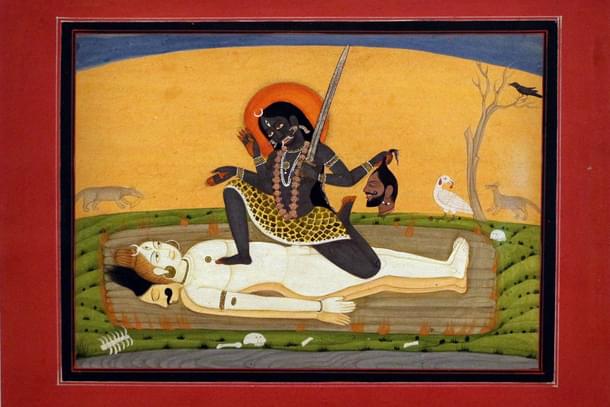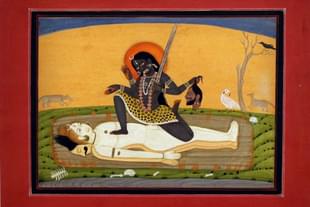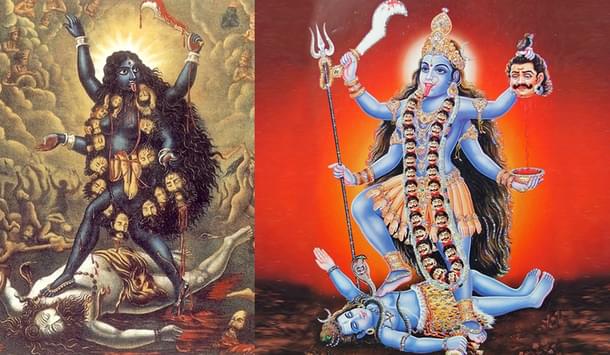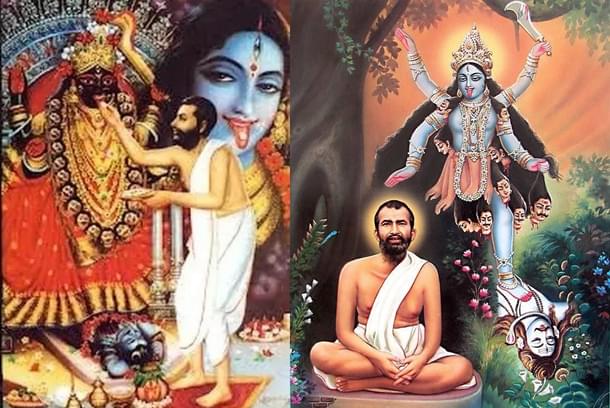Culture
Beyond Outrage Over ‘Sexy’ Goddess Remark: From Juvenile Stupidity To Genuine Rationality
Aravindan Neelakandan
Sep 06, 2020, 07:16 PM | Updated 07:15 PM IST
Save & read from anywhere!
Bookmark stories for easy access on any device or the Swarajya app.


Growing up in Tamil Nadu, one of the examples of double-standards we Hindus consistently faced was the virtual crawling of the so-called ‘rationalists’ before Islamist and evangelist forces while becoming hyper-rationalist towards the Hindu Puranas.
The same can now be scaled up for entire India where assorted 'Breaking India' forces indulge in the same.

The same cannot be said about a Canadian-Iranian activist Armin Navabi.
Navabi created quite a controversy with his ‘sexy’ Goddess tweet. He not only called Hindu goddesses ‘sexy’ but also tweeted a picture of Kali intentionally depicting her in an obscene way.
Hindus cannot blame him of double-standards at least because he had earned notoriety by burning the Quran, which is indeed a life-threatening risk anywhere in the world.
Many Hindus organisations and personalities responded with outrage over his goddess tweet. He responded too.
Dear Hindus. It's not my fault your goddesses are sexy. Maybe put a hijab on them?
— Armin Navabi (@ArminNavabi) September 3, 2020
Here, he seems to have a point, though in a superficial way. He is insinuating that the Hindus in their outrage against his tweet are actually behaving like their Islamist-Christian counterparts. Hence, the hijab jibe.
However, the Hindu outrage does not stem from the imitation of the Islamo-Christian mindset. It has more to do with the deliberate replacing of a sacred context with a male-centric commodification of the sacred-feminine.
So, when a juvenile ‘rationalist’ tweets an obscene picture of the Goddess, removing her from her sacred context, what is actually happening is an abuse of culture at one level and self-abuse at another level.
As a Hindu, we need to reach out to correct both.
The real problem here is the typical shallow approach a Western-trained ‘free-thinking’ mind.
The Western free-thinking tradition had to counter a religion that insisted on taking its mythology literally. So, the Western free-thinkers had to counter it by showing how ridiculous the literal meaning of the sacred text was in the light of modern science.
A free thinker who applies the same template to Hindu context is however incapable of discrimination and is hence, irrational.
It is quite natural for a Westernized mind to think of all religions as being the same as Islam and Christianity. So, they err the same way.
In the case of Armin Navabi what is on display is yet another aspect. He seems to appreciate the bravery of the Hindu depiction of goddesses but he errs or rather commits the blunder of sexualising the Goddess - just as how a male-dominated civilisation objectifies the female body.
Kali, Durga and thousand and one goddesses who make every nook and corner of India sacred, represent the quintessential feminine principles embedded in the very fabric of existence, and which is also transcendental.
The worshipers of the Goddess, who considered themselves as nothing but her children have described her form in language that may be for an untrained and juvenile mind, ‘erotic’.
Let us consider the following lines from one of the greatest mystic-poets of Shaktic tradition from the recent past - Kamalakanta Bhattacharya (1769-1821).
Lying inactive under the woman
He yearns for the sweetness of love.
Whispering endearments into Her ears
Siva makes love to the Beautiful Goddess
in the locus of
the heart lotus of
Kamalakanta
For our juvenile tweeter the above lines may provide nothing but arousal and result in a prude Victorian aversion. But for a Hindu, even a child, these lines of the verse could be understood in their correct cultural and spiritual context.
Because these lines are not mere 'erotic' poetry but poetry that is pregnant with extraordinary layers of meaning, so much so that it can become a poetic depiction of the deeper cosmology modern science unveils.
Consider the following lines by the same mystic-poet:
She is Matter,
and then
She is Shakthi,
She is then the complete Void.
Now know why
contemplating Her,
Kamalakanta
goes mad.
In the West a few have been able to understand this aspect. Physicist Fritjof Capra captures this aspect of the Hindu sacred feminine beautifully and crisply:
The third divinity of this triad is Shakti, the Divine Mother, the archetypal goddess representing in her many forms the female energy of the universe. Shakti also appears as Shiva’s wife and the two are often shown in passionate embraces in magnificent temple sculptures which radiate an extraordinary sensuousness of a degree completely unknown in any Western religious art. Contrary to most Western religions, sensuous pleasure has never been suppressed in Hinduism, because the body has always been considered to be an integral part of the human being and not separated from the spirit.Fritjof Capra, Tao of Physics, Shambala, 1975, p.90
From the colonial rationalists and evangelists who saw Kali as abhorrent and obscene to post-colonial commercial male-centric rationalists who see her as ‘sexy’, what we are witnessing here is a revelation of the deep pathology that pseudo-rationalism harbours in its bosom.
It can only lead to destruction of the self of the person - not because he has blasphemed the Goddess, he cannot. The Hindus even consider blasphemy as a form of worship.
The destruction is more to the self because it shows how pathological the mind that makes such a tweet is and ultimately what it will do to itself.
Puranas point this out when they speak of how the Asuric males always found the Divine Feminine ‘sexy’.
Mahishasura found the form alluring. Every Hindu child knows exactly what Mahishasura and his buffalo form stand for. The tamasic lower drives which drag us down naturally are too lazy to understand the profound beauty of the Goddess which is far more than being mere ‘erotic’.
It is the narrow perception of the Divine Feminine and the egoistic drive to own the Divine Feminine which ultimately leads to the fall.
In what the Western or incompletely developed mind may see ‘the erotic’, the Hindu sees a symbolism that is complete, ever-expanding and deepening.

The enchanting Goddess embracing the masculine principle is also the mother of all the universes. Sri Ramakrishna Paramahamsa explained:
(Yogamaya) signifies the yoga, or union, of Purusha and Prakriti. Whatever you perceive in the universe is the outcome of this union. Take the image of Siva and Kāli. Kali stands on the bosom of Siva; Siva lies under Her feet like a corpse; Kali looks at Siva. All this denotes the union of Purusha and Prakriti. Purusha is inactive; therefore Śiva lies on the ground like a corpse. Prakriti performs all Her activities in conjunction with Purusha. Thus She creates, preserves, and destroys. That is also the meaning of the conjoined images of Radha and Krishna.Gospel of Sri Ramakrishna, p.300
Unfortunately, our Canada-based, Iranian friend has grown up in a cultural milieu which had banished the Goddess for more than two thousand years. It is trying to bring her back hesitatingly and slowly, through tender steps only now.
When a person from such a culture, that too a person not given to much contemplation of any deeper kind, tweets about the Goddess, then that is bound to distort and destroy.
Ursula Le Guin stated this in a very similar context in one of her fictions— if you view the spiritual reality of another culture with a broken mirror in your hand then not only will you get a distorted picture but you will also end up injuring the hand that holds that broken mirror.
The absence of the Goddess and the cultural as well as individual inability to form relations to the Divine Feminine aspect of the self and existence in the West has resulted in suffering and human loss. A good example of this is provided in the depiction of the life and the suffering of American psychologist, William Moulton, the creator of the famous character 'Wonder Woman'.
The 2017 American biographical drama film Professor Marston and the Wonder Women shows the kind of suffering and indignity both the Professor, his family and his son had to face as his father sets out on the journey to discover the Divine Feminine.
After all his suffering the only way he could find an outlet for his quest was through the creation of the comic-character ‘Wonder Woman’ which too had to pass through severe criticism and censorship.
The Yogic-Tantric psychology of Hindus understands such a personality and provides for such a person (of any gender) a path that is not recommended for others. Such a path nevertheless exists with time-tested checks and balances in this culture. It is not recommended for every one. It is approached with extreme caution. But it is not denigrated. A fraction of the image of the Goddess caters to such quests as well.
The Goddess image is a great achievement of human inner evolution. It is only in Hindu Dharma and Hindu Rashtra that image has been preserved and nurtured with all its diversity for all humanity and for all ages to come, for all the seekers.
One wishes Armin Navabi too shall outgrow his juvenile shallowness and ego and grow into Her compassion.
Aravindan is a contributing editor at Swarajya.





